2015 Hyundai Accent check engine
[x] Cancel search: check enginePage 335 of 425
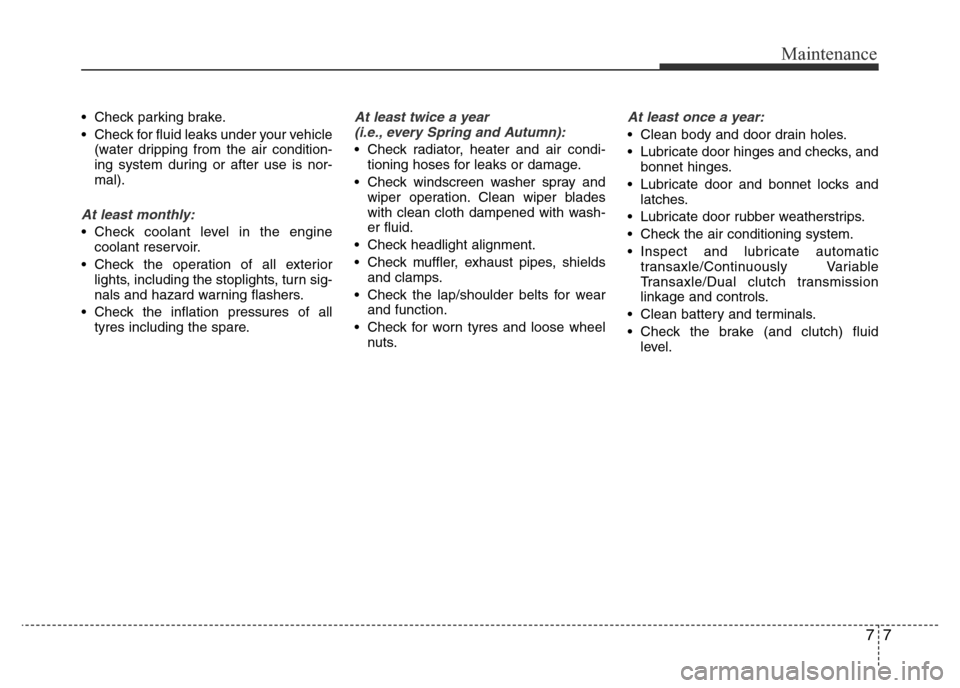
77
Maintenance
• Check parking brake.
• Check for fluid leaks under your vehicle
(water dripping from the air condition-
ing system during or after use is nor-
mal).
At least monthly:
• Check coolant level in the engine
coolant reservoir.
• Check the operation of all exterior
lights, including the stoplights, turn sig-
nals and hazard warning flashers.
• Check the inflation pressures of all
tyres including the spare.
At least twice a year
(i.e., every Spring and Autumn):
• Check radiator, heater and air condi-
tioning hoses for leaks or damage.
• Check windscreen washer spray and
wiper operation. Clean wiper blades
with clean cloth dampened with wash-
er fluid.
• Check headlight alignment.
• Check muffler, exhaust pipes, shields
and clamps.
• Check the lap/shoulder belts for wear
and function.
• Check for worn tyres and loose wheel
nuts.
At least once a year:
• Clean body and door drain holes.
• Lubricate door hinges and checks, and
bonnet hinges.
• Lubricate door and bonnet locks and
latches.
• Lubricate door rubber weatherstrips.
• Check the air conditioning system.
• Inspect and lubricate automatic
transaxle/Continuously Variable
Transaxle/Dual clutch transmission
linkage and controls.
• Clean battery and terminals.
• Check the brake (and clutch) fluid
level.
Page 337 of 425
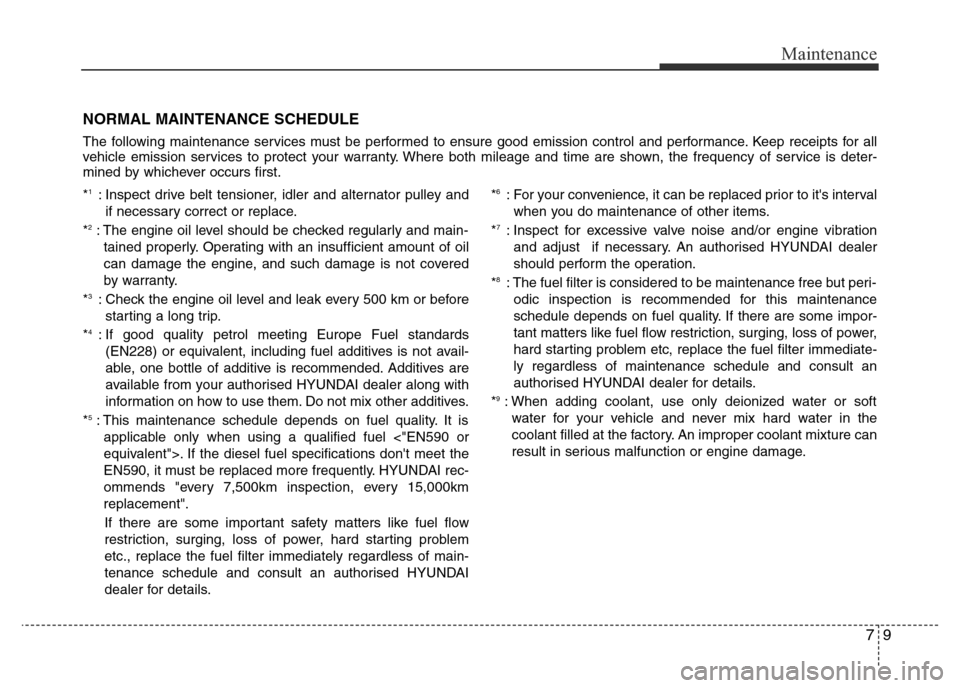
79
Maintenance
NORMAL MAINTENANCE SCHEDULE
The following maintenance services must be performed to ensure good emission control and performance. Keep receipts for all
vehicle emission services to protect your warranty. Where both mileage and time are shown, the frequency of service is deter-
mined by whichever occurs first.
*
1: Inspect drive belt tensioner, idler and alternator pulley and
if necessary correct or replace.
*
2: The engine oil level should be checked regularly and main-
tained properly. Operating with an insufficient amount of oil
can damage the engine, and such damage is not covered
by warranty.
*
3: Check the engine oil level and leak every 500 km or before
starting a long trip.
*
4: If good quality petrol meeting Europe Fuel standards
(EN228) or equivalent, including fuel additives is not avail-
able, one bottle of additive is recommended. Additives are
available from your authorised HYUNDAI dealer along with
information on how to use them. Do not mix other additives.
*
5: This maintenance schedule depends on fuel quality. It is
applicable only when using a qualified fuel <"EN590 or
equivalent">. If the diesel fuel specifications don't meet the
EN590, it must be replaced more frequently. HYUNDAI rec-
ommends "every 7,500km inspection, every 15,000km
replacement".
If there are some important safety matters like fuel flow
restriction, surging, loss of power, hard starting problem
etc., replace the fuel filter immediately regardless of main-
tenance schedule and consult an authorised HYUNDAI
dealer for details.*
6: For your convenience, it can be replaced prior to it's interval
when you do maintenance of other items.
*
7: Inspect for excessive valve noise and/or engine vibration
and adjust if necessary. An authorised HYUNDAI dealer
should perform the operation.
*
8: The fuel filter is considered to be maintenance free but peri-
odic inspection is recommended for this maintenance
schedule depends on fuel quality. If there are some impor-
tant matters like fuel flow restriction, surging, loss of power,
hard starting problem etc, replace the fuel filter immediate-
ly regardless of maintenance schedule and consult an
authorised HYUNDAI dealer for details.
*
9: When adding coolant, use only deionized water or soft
water for your vehicle and never mix hard water in the
coolant filled at the factory. An improper coolant mixture can
result in serious malfunction or engine damage.
Page 343 of 425

715
Maintenance
NORMAL MAINTENANCE SCHEDULE (CONT.)
(Continued)
❑ Inspect vapour hose and fuel filler cap (Petrol)
❑ Replace climate control air filter (if equipped)
❑ Replace engine oil and filter *
2 *3
❑ Replace fuel filter (Petrol) *8
❑ Replace fuel filter cartridge (Diesel) *5
❑ Replace spark plugs (Petrol - MPI)
❑ Replace spark plugs (Petrol - GDI)
(Every 150,000 km or 120 months)
❑ Replace coolant *
9
(At first, 210,000 km or 120months
after that, every 30,000 km or 24months *6)
❑ Inspect cooling system
(At first, 60,000 km or 48months
after that, every 30,000 km or 24months)
No check, No service required
❑Automatic transaxle fluid (6 A/T) (if equipped)
❑Continuously Variable Transaxle fluid (if equipped)
❈Inspect : Inspect and if necessary, adjust, correct, clean or
replace.
Page 346 of 425

Maintenance
18 7
EXPLANATION OF SCHEDULED MAINTENANCE ITEMS
Engine oil and filter
The engine oil and filter should be
changed at the intervals specified in the
maintenance schedule. If the car is being
driven in severe conditions, more fre-
quent oil and filter changes are required.
Drive belts
Inspect all drive belts for evidence of
cuts, cracks, excessive wear or oil satu-
ration and replace if necessary. Drive
belts should be checked periodically for
proper tension and adjusted as neces-
sary.
Fuel filter
A clogged filter can limit the speed at
which the vehicle may be driven, damage
the emission system and cause multiple
issues such as hard starting. If an exces-
sive amount of foreign matter accumu-
lates in the fuel tank, the filter may
require replacement more frequently.
After installing a new filter, run the engine
for several minutes, and check for leaks
at the connections. Fuel filters should be
installed by an authorised HYUNDAI
dealer.
Fuel lines, fuel hoses and con-
nections
Check the fuel lines, fuel hoses and con-
nections for leakage and damage. Have
an authorised HYUNDAI dealer replace
any damaged or leaking parts immedi-
ately.
WARNING - Diesel only
Never work on injection system
with engine running or within 30
seconds after shutting off engine.
High pressure pump, rail, injectors
and high pressure pipes are sub-
ject to high pressure even after the
engine stopped. The fuel jet pro-
duced by fuel leaks may cause seri-
ous injury, if it touch the body.
People using pacemakers should
not move within 30 cm of the ECU
or wiring harness within the engine
room whilst engine is running, high
currents used in the Common Rail
system produce considerable mag-
netic fields.
CAUTION
When you are inspecting the belt,
place the ignition switch in the
LOCK/OFF or ACC position.
Page 347 of 425

719
Maintenance
Vapour hose and fuel filler cap
The vapour hose and fuel filler cap
should be inspected at those intervals
specified in the maintenance schedule.
Make sure that a new vapour hose or fuel
filler cap is correctly replaced.
Vacuum crankcase ventilation
hoses (if equipped)
Inspect the surface of hoses for evidence
of heat and/or mechanical damage. Hard
and brittle rubber, cracking, tears, cuts,
abrasions, and excessive swelling indi-
cate deterioration. Particular attention
should be paid to examine those hose
surfaces nearest to high heat sources,
such as the exhaust manifold.
Inspect the hose routing to assure that
the hoses do not come in contact with
any heat source, sharp edges or moving
component which might cause heat dam-
age or mechanical wear. Inspect all hose
connections, such as clamps and cou-
plings, to make sure they are secure, and
that no leaks are present. Hoses should
be replaced immediately if there is any
evidence of deterioration or damage.
Air cleaner filter
A Genuine HYUNDAI air cleaner filter is
recommended when the filter is
replaced.
Spark plugs (for petrol engine)
Make sure to install new spark plugs of
the correct heat range.
Valve clearance (Petrol 1.6L)
Inspect excessive valve noise and/or
engine vibration and adjust if necessary.
An authorised HYUNDAI dealer should
perform the operation.
Cooling system
Check cooling system components, such
as radiator, coolant reservoir, hoses and
connections for leakage and damage.
Replace any damaged parts.
Coolant
The coolant should be changed at the
intervals specified in the maintenance
schedule.
WARNING
Do not disconnect and inspect
spark plugs when the engine is hot.
You may burn yourself.
Page 348 of 425
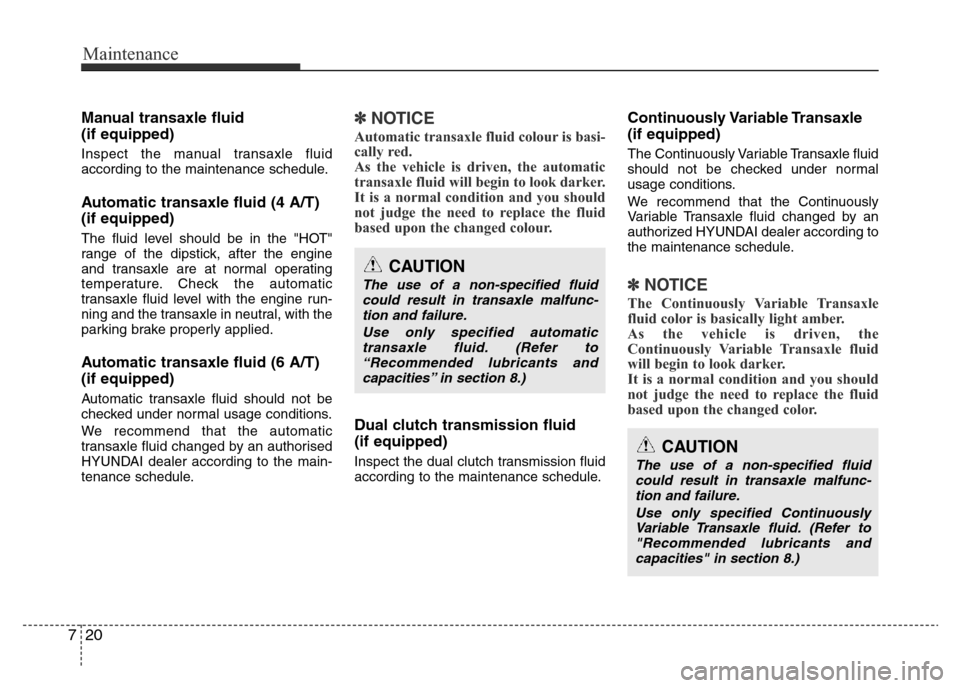
Maintenance
20 7
Manual transaxle fluid
(if equipped)
Inspect the manual transaxle fluid
according to the maintenance schedule.
Automatic transaxle fluid (4 A/T)
(if equipped)
The fluid level should be in the "HOT"
range of the dipstick, after the engine
and transaxle are at normal operating
temperature. Check the automatic
transaxle fluid level with the engine run-
ning and the transaxle in neutral, with the
parking brake properly applied.
Automatic transaxle fluid (6 A/T)
(if equipped)
Automatic transaxle fluid should not be
checked under normal usage conditions.
We recommend that the automatic
transaxle fluid changed by an authorised
HYUNDAI dealer according to the main-
tenance schedule.
✽NOTICE
Automatic transaxle fluid colour is basi-
cally red.
As the vehicle is driven, the automatic
transaxle fluid will begin to look darker.
It is a normal condition and you should
not judge the need to replace the fluid
based upon the changed colour.
Dual clutch transmission fluid
(if equipped)
Inspect the dual clutch transmission fluid
according to the maintenance schedule.
Continuously Variable Transaxle
(if equipped)
The Continuously Variable Transaxle fluid
should not be checked under normal
usage conditions.
We recommend that the Continuously
Variable Transaxle fluid changed by an
authorized HYUNDAI dealer according to
the maintenance schedule.
✽NOTICE
The Continuously Variable Transaxle
fluid color is basically light amber.
As the vehicle is driven, the
Continuously Variable Transaxle fluid
will begin to look darker.
It is a normal condition and you should
not judge the need to replace the fluid
based upon the changed color.
CAUTION
The use of a non-specified fluid
could result in transaxle malfunc-
tion and failure.
Use only specified automatic
transaxle fluid. (Refer to
“Recommended lubricants and
capacities” in section 8.)
CAUTION
The use of a non-specified fluid
could result in transaxle malfunc-
tion and failure.
Use only specified Continuously
Variable Transaxle fluid. (Refer to
"Recommended lubricants and
capacities" in section 8.)
Page 349 of 425
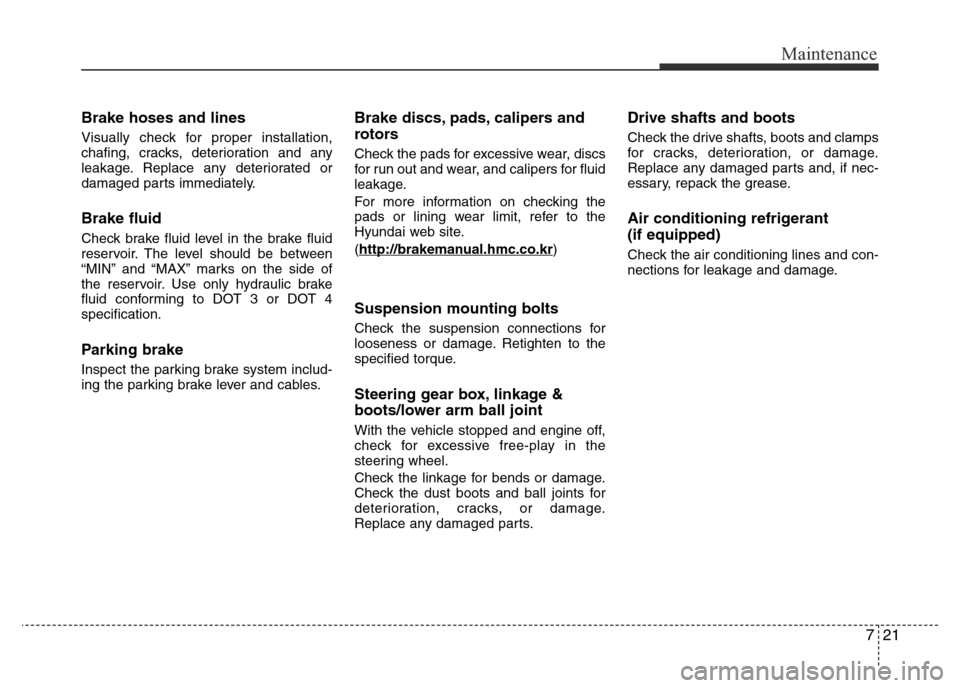
721
Maintenance
Brake hoses and lines
Visually check for proper installation,
chafing, cracks, deterioration and any
leakage. Replace any deteriorated or
damaged parts immediately.
Brake fluid
Check brake fluid level in the brake fluid
reservoir. The level should be between
“MIN” and “MAX” marks on the side of
the reservoir. Use only hydraulic brake
fluid conforming to DOT 3 or DOT 4
specification.
Parking brake
Inspect the parking brake system includ-
ing the parking brake lever and cables.
Brake discs, pads, calipers and
rotors
Check the pads for excessive wear, discs
for run out and wear, and calipers for fluid
leakage.
For more information on checking the
pads or lining wear limit, refer to the
Hyundai web site.
(http://brakeman
ual.hmc.co.kr)
Suspension mounting bolts
Check the suspension connections for
looseness or damage. Retighten to the
specified torque.
Steering gear box, linkage &
boots/lower arm ball joint
With the vehicle stopped and engine off,
check for excessive free-play in the
steering wheel.
Check the linkage for bends or damage.
Check the dust boots and ball joints for
deterioration, cracks, or damage.
Replace any damaged parts.
Drive shafts and boots
Check the drive shafts, boots and clamps
for cracks, deterioration, or damage.
Replace any damaged parts and, if nec-
essary, repack the grease.
Air conditioning refrigerant
(if equipped)
Check the air conditioning lines and con-
nections for leakage and damage.
Page 350 of 425
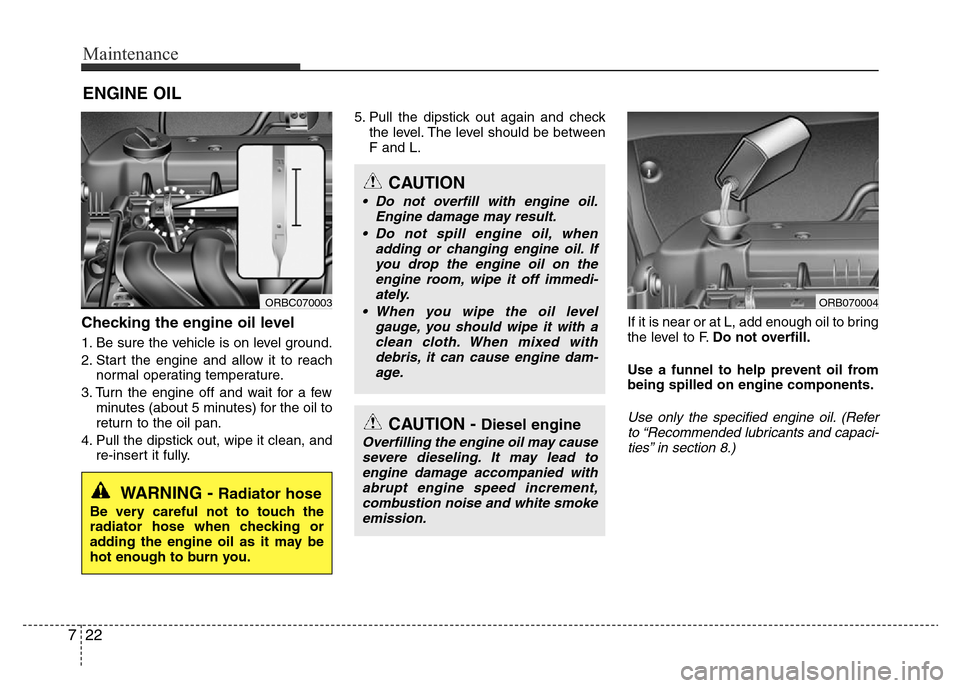
Maintenance
22 7
ENGINE OIL
Checking the engine oil level
1. Be sure the vehicle is on level ground.
2. Start the engine and allow it to reach
normal operating temperature.
3. Turn the engine off and wait for a few
minutes (about 5 minutes) for the oil to
return to the oil pan.
4. Pull the dipstick out, wipe it clean, and
re-insert it fully.5. Pull the dipstick out again and check
the level. The level should be between
F and L.
If it is near or at L, add enough oil to bring
the level to F.Do not overfill.
Use a funnel to help prevent oil from
being spilled on engine components.
Use only the specified engine oil. (Refer
to “Recommended lubricants and capaci-
ties” in section 8.)
WARNING - Radiator hose
Be very careful not to touch the
radiator hose when checking or
adding the engine oil as it may be
hot enough to burn you.
ORBC070003
CAUTION
• Do not overfill with engine oil.
Engine damage may result.
• Do not spill engine oil, when
adding or changing engine oil. If
you drop the engine oil on the
engine room, wipe it off immedi-
ately.
• When you wipe the oil level
gauge, you should wipe it with a
clean cloth. When mixed with
debris, it can cause engine dam-
age.
CAUTION - Diesel engine
Overfilling the engine oil may cause
severe dieseling. It may lead to
engine damage accompanied with
abrupt engine speed increment,
combustion noise and white smoke
emission.
ORB070004